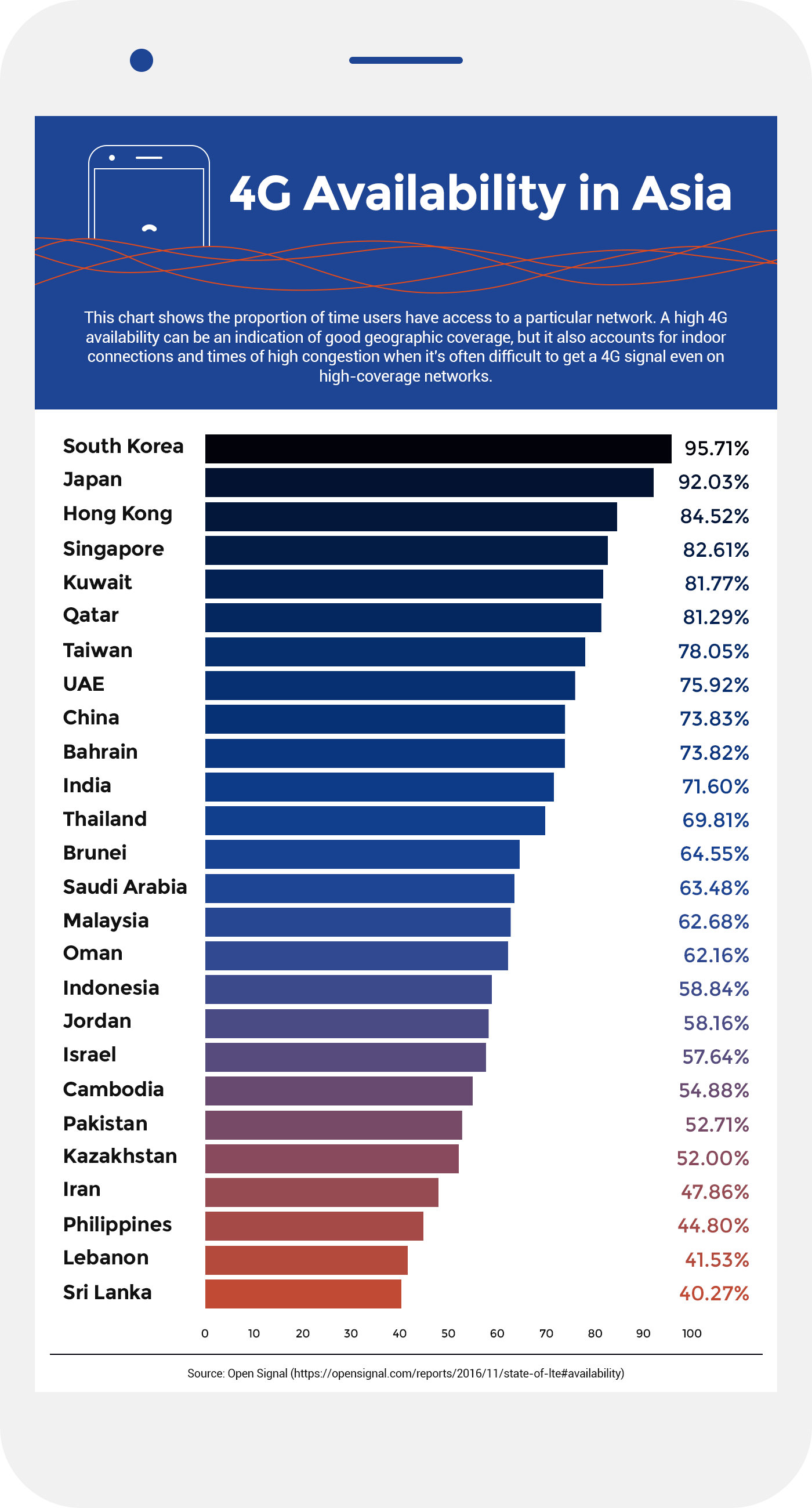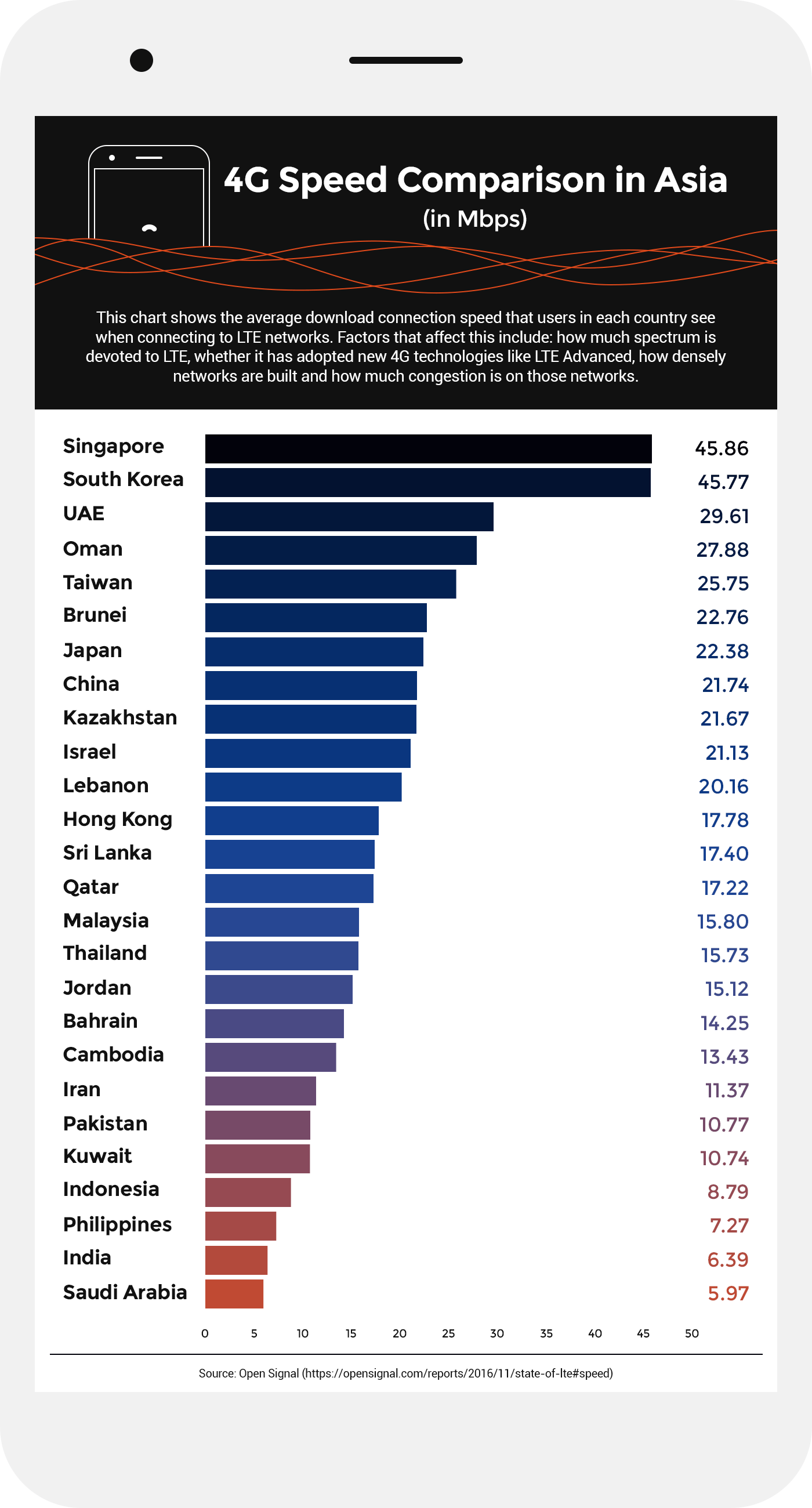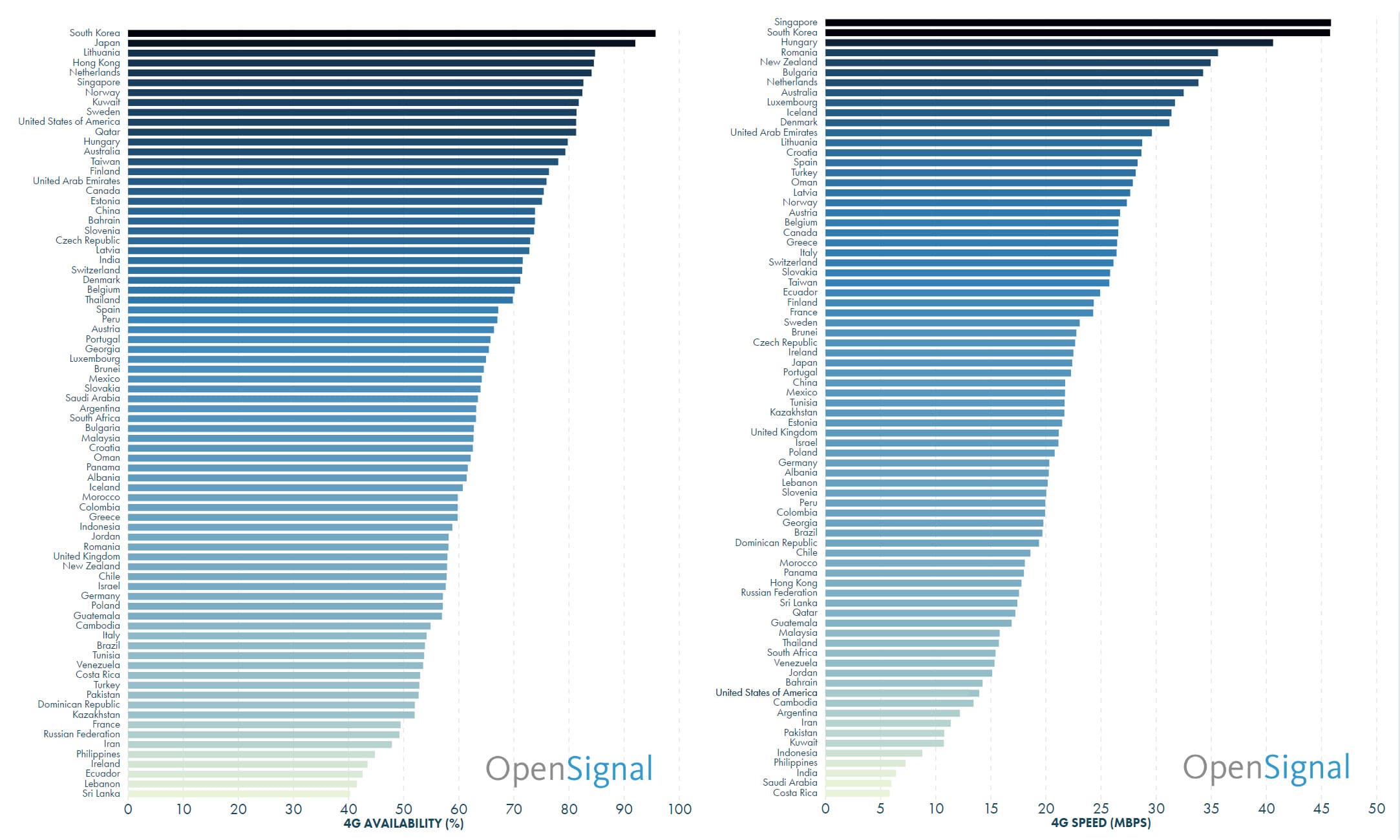Enterprise
Singapore, S. Korea dominate 4G LTE rankings, Philippines struggles

Crowdsourced mobile data from OpenSignal revealed some interesting figures for the third quarter of 2016. Based on statistics published today, Singapore and South Korea have the best 4G data speeds and nationwide availability, respectively. Asian neighbors India, Indonesia, and the Philippines didn’t do nearly as well.
4G LTE connectivity is expanding at an exponential rate across the globe, and gradually eclipsing the older 3G technologies from a generation ago. Unfortunately, not every country is experiencing equal opportunities, and some are left wondering where all the bandwidth is going.
Singapore gets top honors for 4G speeds in the world, averaging a blistering 45.86 megabits per second (Mbps). This means you can wirelessly download files at 5.7 megabytes per second (MBps — notice the uppercase B). Remember that a megabyte is equal to eight megabits.
The city-state is followed closely by South Korea at 45.77Mbps, Hungary at 40.61Mbps, and Romania at 35.61Mbps. You have to go all the way down to 25.75Mbps to discover the next-fastest East Asian nation, Taiwan. How about high-tech Japan? Its citizens are enjoying 22.38Mbps.
Even though the majority of the included countries averaged more than 20Mbps, the global average is only 17.4Mbps. We can the blame the terribly low speeds of developing nations for dropping the number.
Indonesia, the Philippines, and India were particularly bad for Asia, averaging only 8.79Mbps, 7.27Mbps, and 6.39Mbps, respectively. It gets even more embarrassing when you combine the three, giving you a total of 22.45Mbps, just above the global norm.

For nationwide availability, OpenSignal doesn’t measure geographic reach; rather, the metric tracks the “proportion of time users have access to a particular network.” This places indoor connections and moments of high network congestion into consideration, putting all participants on a more level playing field. Garnering a score of 50 percent means users have 4G access half of the time.
South Korea has a near perfect score of 95.71 percent, followed by Japan’s 92.03 percent and Lithuania’s 84.73 percent. The worst-performing countries are Sri Lanka (40.27%), Lebanon (41.53%), Ecuador (42.56%), Ireland (43.45%), and the Philippines (44.8%).
Notice something? Yeah, the Philippines ranks in the bottom five for both 4G speeds and availability. Fingers can be pointed at multiple excuses, such as the difficulty in covering an archipelago and the country’s mobile network duopoly, but the fact remains that the Pacific-based republic struggles to keep up with evolving wireless standards.
Take note, however, that even though this is a global survey comprising 78 countries, numerous African and Asian regions are excluded because they lack test data for fair analysis.
Click the image for a closer look
You can find the complete set of statistics on OpenSignal’s website, complete with interactive maps and graphs. It’s all quite fascinating, and will either enlighten or frustrate you, depending on where you live.
If you want to contribute to the cause, you can download OpenSignal’s app for Android or iOS. On top of collecting data, it can also help you find more stable network connections and nearby Wi-Fi hotspots around the globe.
Confused by some of the terminology? Watch our LTE-A explainer video to bring you up to speed:

For the longest time, Google kept Pixel and Android behind two different teams. While the Pixel team dealt with devices made by and for the brand, the Android team ships a product meant for brands outside of the company’s purview. However, the days of separation are at an end. Google is officially merging its Pixel and Android teams together.
In a shocking announcement, the company has confirmed that the teams handling hardware and software will fall under a single team headed by Rick Osterloh. Prior to the merge, Osterloh was the senior vice president of devices and service, which was Google’s hardware branch. He will now oversee both hardware and software.
Because of the new leadership change, Hiroshi Lockheimer, former head of Android, will now move on to other projects within Alphabet. Of note, the change is not harsh for Lockheimer. He and Osterloh had been contemplating on the merge for a while.
Now, why the change? As is the case with everything today, it’s all because of AI. Speaking to The Verge, Osterloh explains that the merge will help with “full-stack innovation.” With how technology is these days, it’s now impossible to develop AI without having a close eye on hardware, such as in Google’s AI developments for the Pixel camera. Merging the teams will help streamline development, especially when hardware is involved.
Despite the change, outside brands, like Qualcomm’s Cristiano Amon, remains confident of Android’s capabilities outside of Google. Just expect more AI coming out in the near future.

The ongoing trade war between the United States and China is putting a lot of companies out of business in one country. While all eyes are currently on America’s crusade against TikTok, China has launched a salvo of its own. The country has started banning AMD and Intel, starting with government devices.
Recently, as reported by the Financial Times, China has introduced a new rule that bans American chipsets and servers from government agencies. The new ban includes AMD, Intel, and Microsoft Windows.
In lieu of the now-banned brands, Chinese government agencies must use approved brands from a list of 18 Chinese manufacturers. Unsurprisingly, the list includes Huawei, another brand involved in the ongoing trade war. (Huawei is still banned on American soil.)
As with bans from America, China’s latest rules stem from a desire to implement national security. Both countries allege that using brands from the opposing side will open a potential avenue for transferring classified information.
Currently, the ban against the American chipsets are only affecting government devices. However, if it follows the same trajectory as Huawei and TikTok in the United States, a government-only ban might soon lead to an all-out ban on consumer devices. As TikTok is currently hanging in the balance, it’s unlikely that the trade wars will cool down anytime soon.

So far, Apple’s greatest enemy has been the European Union. Months and months of claiming that the company engages in anti-competitive practices, the region has successfully caused Apple to drastically change a lot of things about the iPhone including the Lightning cable. Now, a new challenger wants Apple to answer for its supposed grip on the industry: the United States government.
Today, the Department of Justice is officially suing Apple for supposedly monopolizing the smartphone industry and stifling competition. The lawsuit alleges that Apple’s lineup of products prevent users from trying out other brands. For example, Apple limits how well a third-party smartwatch works on an iPhone, pushing users to go for an Apple Watch instead.
The lawsuit also includes an important pain point in Apple’s fight in Europe. It says that the company makes it difficult for iPhone users to communicate with Android users (and vice versa). Late last year, the company already committed to supporting RCS as a messaging standard, finally easing communication between the two systems. Their adoption has yet to arrive, though.
Though not as stringent as Europe, the American government is no slouch when it comes to questioning its own companies for pursuing anti-competitive practices. In the past, it went through Google and Spotify to protect the interests of its citizens. The lawsuit against Apple is no different, gathering signatures from sixteen states.
For Apple’s part, the company aims to get the case dismissed, alleging the lawsuit’s unfair scope of just the American people when it targets the entire world.
SEE ALSO: Apple opens first Developer Center in Southeast Asia
-

 Events2 weeks ago
Events2 weeks agoStellar Blade: PlayStation taps cosplayers to play Eve for game’s launch
-

 Features1 week ago
Features1 week agoFortify your home office or business setup with these devices
-

 Accessories2 weeks ago
Accessories2 weeks agoLogitech unveils G Pro X 60 gaming keyboard: Price, details
-

 Reviews1 week ago
Reviews1 week agorealme 12+ 5G review: One month later
-

 Deals2 weeks ago
Deals2 weeks agoTCL P635 TV: Big savings for TCL’s anniversary
-

 Gaming1 week ago
Gaming1 week agoNew PUMA collection lets you wear PlayStation’s iconic symbols
-

 Accessories1 week ago
Accessories1 week agoMarshall Major V: Reasons Why I Love It
-

 Gaming1 week ago
Gaming1 week agoMore PlayStation 5 Pro specs have been leaked




























